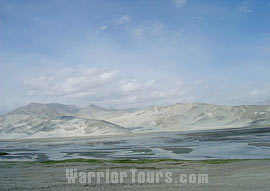- Abakh Khoja Tomb & Local Bazaar
- Id Kah Mosque
- Karakuri Lake & Three Immortals Buddhist Caves
Karakuri Lake & Three Immortals Buddhist Caves

![]() Karakuri Lake
Karakuri Lake
As the water source of local people, Karakuri Lake lies at the foot of an ice mountain east of Pamirs. The altitude of this lake is 3,600 meters (about 11,811 feet), with a depth of 30 meters (about 98 feet). The area of the lake surface is 10 square kilometers (about 4 square miles). Karakuri means, 'black sea', but the water in the lake is crystal clear. Ranges of mountains surround Karakuri Lake. Grass and other plants beside the lake shore grow vigorously. On sunny days all of the majestic surroundings are reflected in the lake, transforming it into a spectacular painting, which makes you feel overwhelmed with beauty.
Karakuri Lake is a moraine-type of lake created by ice erosion. It is covered by white snow almost all year round. The silver mountains and green grass lands beside the lake are like the reflections in a mirror and form a charming picture that will make you appreciate the sublime grandeur of nature.
![]() Getting there:
Getting there:
You can take bus in Kashgar from the long-distance bus station to get to this amazing lake. The bus will depart at 08:30 every morning.
| Admission Fee: | CNY 50 (Excluding CNY10 for Border Permit) |
| Opening Hours | 08:00-17:00 |
| Best Visit Time: | August, September |
![]() Three Immortals Buddhist Caves
Three Immortals Buddhist Caves
The Three Immortals Buddhist Caves are in the northern part of Kashgar City. Having been carved during the Eastern Han Dynasty (206 BC-24 AD), these caves are the oldest Buddhist fresco caves in the western region of China, and they are well-preserved. Each of the three caves is divided into a front room and back room, with the front room always bigger than the back one.
Among the three caves, the middle cave is the biggest, with a height of 2 meters (about 6 feet) and a width of 1.5 meters (about 5 feet). There is only an unfinished, headless Buddha statue in the back room of the middle cave. The west cave is still in its virgin state because it was unfinished at the beginning of the cutting. There is nothing in this cave. There are various kinds of Buddhist paintings covering the walls of the front room of the east cave. The standing Buddha statue in the back room is life-like, vivid and elegant. The upper part of this Buddha's body is naked. His right hand is parallel with his waist, while his left hand is lying along his leg naturally. The most amazing about this statue is that there are three kinds of colors, green, red and blue interwoven in his lower part. It is very rare to see Buddha cave paintings in China. The entire cave is evidence of the fertile imagination and lofty skills of the ancient Chinese people.
Note: The cave is very dangerous and we do not suggest it as a sight seeing spot.

